Recently, JAR interviewed author Stephen L. Kling, Jr. about the American Revolutionary War in the West Museum Exhibit at the St. Charles County Heritage Museum in St. Peters, Missouri.
How did the ‘American Revolutionary War in the West’ museum exhibit come about?
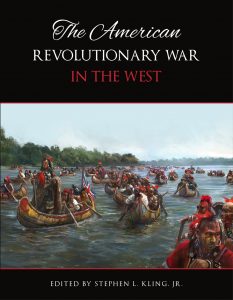 The exhibit grew out of an earlier book I wrote on the Battle of St. Louis and a documentary entitled House of Thunder made by HEC-Media on that book. During filming, which started in 2018, I began discussions with some of the documentary interviewees about the need to do an expanded book covering all of the events in the west based upon primary sources. While the film won the St. Louis Filmmakers award and a Mid-American Emmy for best historical documentary in 2021, we all realized early on that few people knew about the events in the west. I purposely structured the new book, The American Revolutionary War in the West, in a way that it could be the basis for an extensive museum exhibit on the events covered. Of note was the unparalleled access we had to the Spanish archives in Seville, Spain through the efforts of one of our Spanish co-authors, Kristine Sjostrom, who lives in Seville (where the archives are located) and had been researching the Louisiana and Florida documents for over a decade. Other authors of the book whose expertise was invaluable to the exhibit include Morris Arnold, Ken Carstens, Thomas Chávez, Molly Long Fernandez de Mesa, Kristin Condotta Lee, Robert Moore, Robert Mueller, Larry Nelson, Mary Anthony Startz, and Frances Kolb Turnbell.
The exhibit grew out of an earlier book I wrote on the Battle of St. Louis and a documentary entitled House of Thunder made by HEC-Media on that book. During filming, which started in 2018, I began discussions with some of the documentary interviewees about the need to do an expanded book covering all of the events in the west based upon primary sources. While the film won the St. Louis Filmmakers award and a Mid-American Emmy for best historical documentary in 2021, we all realized early on that few people knew about the events in the west. I purposely structured the new book, The American Revolutionary War in the West, in a way that it could be the basis for an extensive museum exhibit on the events covered. Of note was the unparalleled access we had to the Spanish archives in Seville, Spain through the efforts of one of our Spanish co-authors, Kristine Sjostrom, who lives in Seville (where the archives are located) and had been researching the Louisiana and Florida documents for over a decade. Other authors of the book whose expertise was invaluable to the exhibit include Morris Arnold, Ken Carstens, Thomas Chávez, Molly Long Fernandez de Mesa, Kristin Condotta Lee, Robert Moore, Robert Mueller, Larry Nelson, Mary Anthony Startz, and Frances Kolb Turnbell.
Tell us briefly about the museum exhibit.
The exhibit has four main sections:
- The American Revolutionary War Comes to the West
- The British Response
- The Battle of St. Louis and Attack on Cahokia
- The War in the West Continues
Within those sections are twenty-three story areas in chronological order covering the events in the west. The exhibit includes forty-two uniformed and costumed mannequins, over one-hundred period artifacts and weapons, dozens of newly-commissioned artwork and maps, copies of pertinent documents (several of which had never been published), dioramas, a regimental flag array, AV touchscreens with expert interviews and more. A particular emphasis was made to cover people involved as the events in the west had a very diverse mix—Americans, African Americans, British, French, Native Americans and Spanish people were all involved.
The American Revolutionary War in the West, the book upon which the exhibit is based, is a three-hundred-plus-page large format, hardbound, all color and heavily footnoted publication. However, to open this history up to the many museum visitors who have little or no knowledge of this history, a forty-page museum guide booklet is available which is also in full color with many images and maps to be as inviting as possible.
How did you approach the process of researching and composing the exhibit? Was it any more difficult, or easier, than you expected?
The blueprint for the exhibit was The American Revolutionary War in the West book. The book has chapters written by many of the leading experts on aspects of the western theater of the war. Their expertise and writing provided extensive new information and insights on the war which found their way into the exhibit. Several other people outside the author group provided specialized assistance, such as archaeologist and Chickasaw tribal member Donna Loksi’ Rausch, National Park Service eighteenth century weapons expert Douglas Harding, Spanish professor Shenika Harris, former French professor Nancy Durbin, and Kaskaskia historian Emily Lyons. Even the local British Consul voiced a segment in an AV touchscreen display on the British plans to conquer the Mississippi River Valley.
Covid-19 caused considerable problems in bringing the exhibit to reality. Fortunately, I found a great partner: the County of St. Charles, which owns a new museum building, to engage museum designers, assign their historians and curators to assist and cover the considerable cost of constructing the exhibit. The County of St. Charles was particularly excited about the exhibit because the founder of the City of St. Charles, Louis Blanchette, was in the Spanish militia at the Battle of St. Louis. We all envisioned an extensive exhibit that would be visually stunning and of interest to people of all ages. For example, there are seven child mannequins. While the exhibit was a huge undertaking, we all stuck to a detailed and ambitious schedule and everyone’s efforts made the process relatively smooth.
Were you able to obtain the information and artifacts that you were hoping to?
Yes. Information for the exhibit almost exclusively came from the book. I had personally been collecting artifacts and other period items for many years and several people loaned items for display. For example, Professor Ken Carstens loaned artifacts from his archaeological digs at Fort Jefferson. Many artifacts were somewhat unique to the west—Spanish miquelet lock muskets and pistols, British Indian Department weapons, extensive Native trade goods, weapons and regalia, Indian peace medals, Indian war captain gorgets, and French hunting swords, to name a few. We even have an original period British newspaper article covering the Spanish conquest of the British Mississippi River forts.

How did you decide when to use original artifacts, and when to use reproductions?
For the most part, the display items were original items while all of the equipment and accoutrements on the uniformed and costumed mannequins were replicas. We had a great number of unique suppliers and artisans involved to make many special replica items for the mannequins, such as quillwork pouches, moccasins, German Waldeck equipment, regimental buttons, finials, gorgets, and armbands. Permission to display copies of a number of never-before-published documents from the British, American, and Spanish archives and records was also obtained. For example, a copy of the British orders authorizing the attacks against St. Louis, Cahokia, and New Orleans can be found in the British Grand Plan section. Another copied document is a detailed list of all of the casualties and prisoners from the Battle of St. Louis obtained from the Archivo General de Indias in Spain.
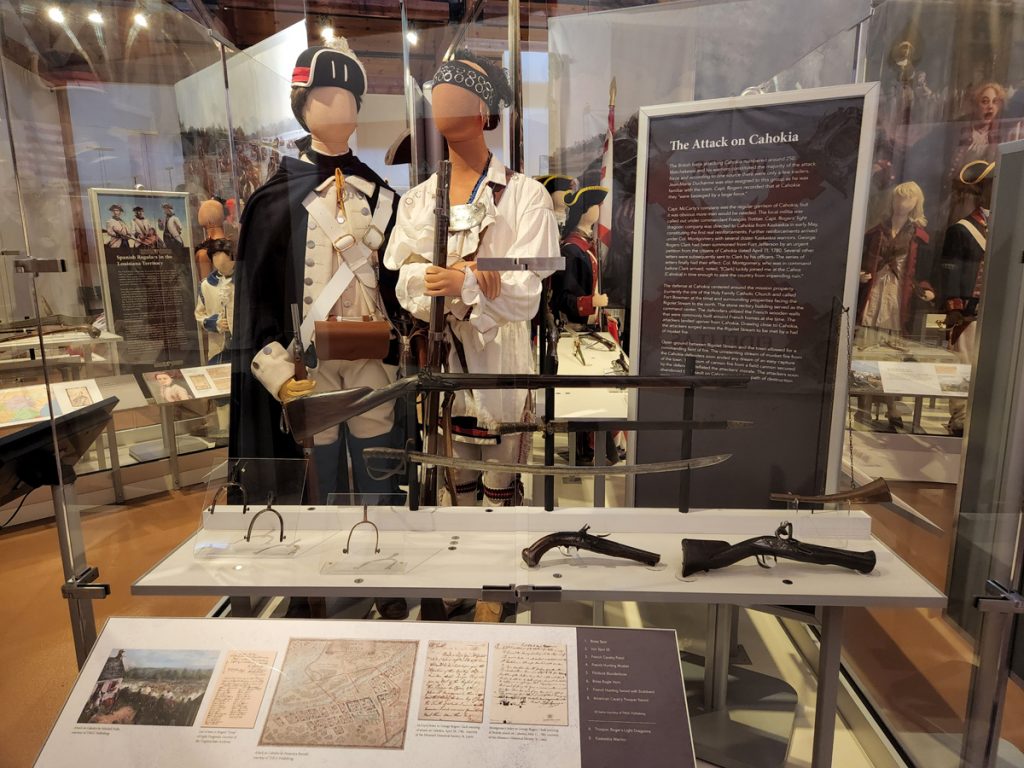
What challenges did you face in obtaining original artifacts or suitable replicas?
Pandemic-related shortages and shipping delays posed the biggest challenge. However, most of the suppliers of replicas prioritized or expedited our orders when they learned their items were going to be part of this exhibit. The pandemic also made it difficult to film interviews of the authors and the experts for the AV touchscreens used in the exhibit. The artifacts were less of a problem since I had been searching for and collecting them for years in anticipation of this effort. The exhibit also includes an extensive amount of new artwork and maps. My team of artists, who had worked with me on prior books and projects and were familiar with the types of themes and details I desired, made stunning works depicting battles and events for the new book and the exhibit.
How did your own understanding of the American Revolution change as you researched and composed the exhibition?
The biggest takeaway was the significance of the events in the west. Had the battles for St. Louis and Cahokia been lost, a very good argument can be made that the new territories west of the Alleghenies would not have been awarded to the United States at the end of the war. Historian Andrew Jackson O’Shaughnessy came to the same conclusion as reflected in his interviews during the House of Thunder filming. If Spain had lost Louisiana or even Upper Louisiana, the Louisiana Purchase might have never happened either.
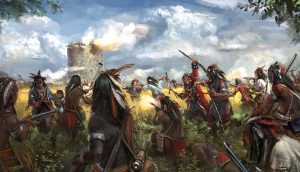
I was also amazed at the volume of available records which provide a rich history of many individuals caught up in the events in the west. Despite this, little effort has been made previously to tell a comprehensive story of the war in the west. People like Father Gibault, the “Patriot Priest,” who helped win many of the local French over to the American cause; James Colbert, a loyalist Chickasaw leader who was present at many of the western battles; Cesar, a black artisan who was enslaved by one of George Rogers Clark’s lieutenants and who repaired all of Clark’s forts; Wapasha, an Eastern Dakota chief and leader of the attack on St. Louis; Madame Ortes Barada who lived to 106 and recalled the famous strawberry picking story relating to the attack on St. Louis; and Captain Jean Baptiste Hamelin, a French heritage local who died during an attack against British Fort St. Joseph where supplies were being stockpiled for another attack against St. Louis; all of these, among many others, are depicted in the exhibit.
What was your biggest revelation or surprise?
The documentation of the extensive friendship between Spanish Lt. Governor Fernando de Leyba, stationed at St. Louis, and George Rogers Clark, and the vital assistance the Spanish provided the Americans during the war. Clark met with Leyba on several occasions and even attended a ball at St. Louis with a subsequent dinner with thirty-six place settings. His letters with Leyba clearly indicated a close relationship, with Clark’s letters often ending with a request to give his best to the “little misses,” referring to Leyba’s two daughters. Of more significance to the general war effort was the Spanish aid to the Americans. The Spanish funneled a huge amount of war supplies from New Orleans to the Americans, not only to Clark in the west but also by way of Fort Pitt to forces further east. Clark and his men even referred to the supplies at St. Louis as the “Continental Store.”
Other surprises of note were the extensive involvement of African American contributors such as special black sharpshooters known as “tireurs ou chasseurs” requested by Governor Gálvez for his Mississippi River campaign, the invaluable aid that the Kaskaskia tribe provided to George Rogers Clark, the use of cavalry units, and the extensive participation of the local French and Native Americans on all sides.
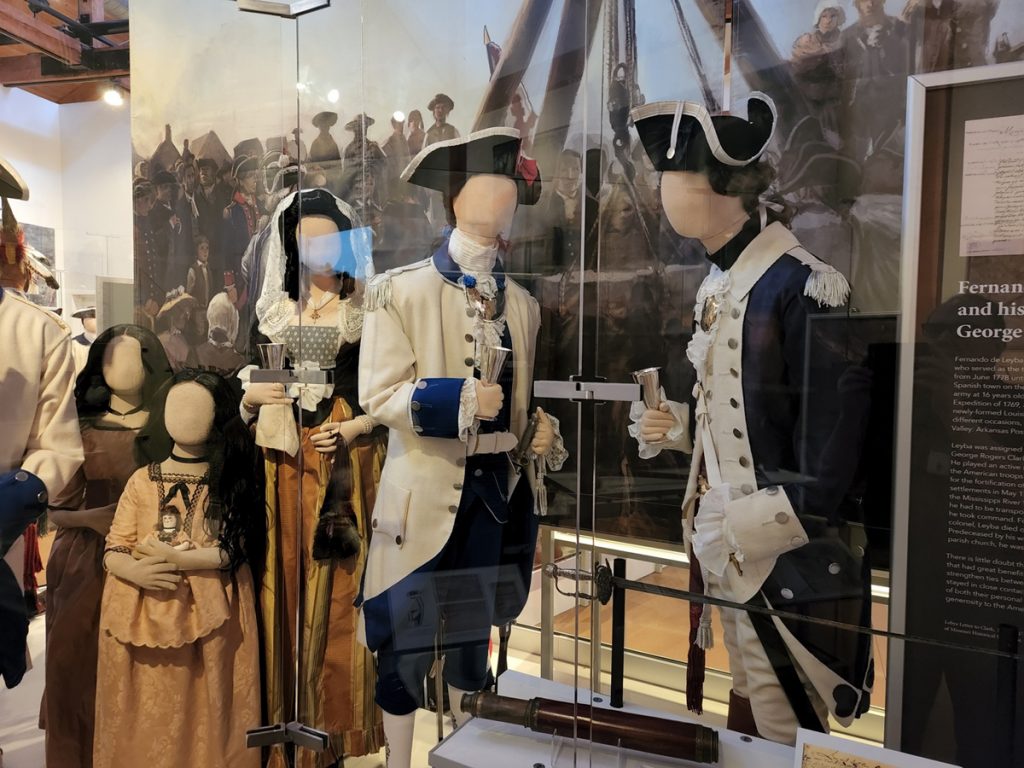
What is your favorite item in the exhibit?
I don’t know that I have a favorite item. The exhibit contains so much spectacular artwork, costumes, and artifacts, it is really hard to think of one. I guess if I had to pick something, it would be the artwork showing the British attack force on the Mississippi River on their way to St. Louis. This image was not only used in the exhibit for a large hanging tapestry, but also for the cover of The American Revolutionary War in the West. As to artifacts, I particularly enjoy the Spanish and British Indian Peace Medals and companion certificates as they seem to exemplify the diverse makeup of the war in the west.
What is your favorite story area in the exhibit?
While personal biographies and individually named mannequins are peppered throughout the exhibit, in one area there is a concentration of six mannequins and stories from the Battle of St. Louis. These include Madame Honoré, who canoed hundreds of miles by herself to warn St. Louis of the impending attack; Pierre Ignace dit Valentin, the free black gunsmith who repaired the militia muskets; Madame Vegette and her two daughters, who all survived being shot during their harrowing escape back to the town in a two-horse cart at the beginning of the attack; and Madame Rigauche who donned her husband’s militia coat and grabbed a pistol at the first sign of the attack and rushed to the main gate to urge the men on. Popular stories after the attack inflated the latter’s involvement to one of almost single-handedly saving St. Louis. It was fun working from the popular stories to find documented evidence of all these people in contemporary letters, baptism and marriage records and even the casualty lists from the battle.
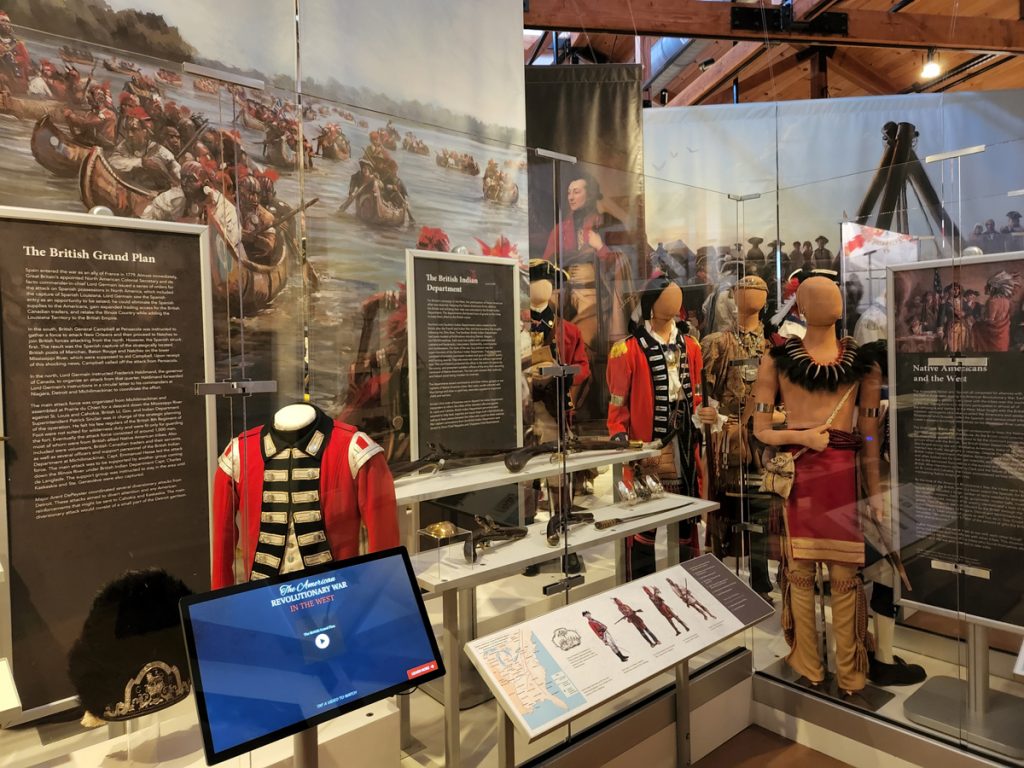
For those who cannot visit in person, is there a way to experience some of the exhibits online?
In part, yes. The museum has a number of videos up on their Facebook page and HEC-Media did a short review video which can be found here. I am also available to do a zoom or in-person presentation—I have done dozens over the last few months and they have been well-received. Of course, TheAmerican Revolutionary War in the West, the museum guide booklet, and several other books and games relating to the history and the House of ThunderDVD can all be purchased at the museum or on my website, thgcpublishing.com.
I have developed some historical battle games for museums in the past and purposely released several American Revolutionary War themed games for the museum opening which include “The Battle of St. Louis,” “The Attack on Cahokia,” “The Attack on Fort Jefferson,” “The Battle of Baton Rouge,” “The Battle of Yorktown” and “The Battle of Saratoga.” These are low-complexity games that even young teenagers can enjoy and will hopefully help generate additional interest in this history.
What are some details about location, hours, and admission?
The American Revolutionary War in the West Exhibit will run for two years. The museum is named the Heritage Museum and is located in St. Charles County, Missouri just across the Missouri River from St. Louis County. The address is 1630 Heritage Landing, St Peters, MO 63303 and the phone number is (636) 255-6000. Admission is free, and hours are:
Wednesday 10:00 a.m.–5:00 p.m.
Thursday 10:00 a.m.–5:00 p.m.
Friday 10:00 a.m.–5:00 p.m.
Saturday 10:00 a.m.–5:00 p.m.
Sunday 12:00 p.m.–5:00 p.m.
Is there anything else you want to add?
I want to thank all of the book authors, donors, suppliers, artisans, artists, the County of St. Charles and its staff, Riggs Ward and Building Four Fabrication who helped design and fabricate the exhibit layout, my primary uniform and costume maker Kathy Nadeau, my assistant Melissa Edwards, Joan Koechig and other officers of the St. Charles County Historical Society, and a large host of others who helped make the exhibit happen. This is a unique and fabulous display and it is rewarding to hear high praise from all visitors about our efforts to bring this segment of the American Revolutionary War to life.










2 Comments
Fantastic. Hope I can get out there to see it before the exhibit ends. How long do you think the exhibit will run?
Eric, it is under contract for 2 years. I sent a couple emails to ERW with some info about this. Let me know if you plan on coming and I can try to arrange to give you a tour.